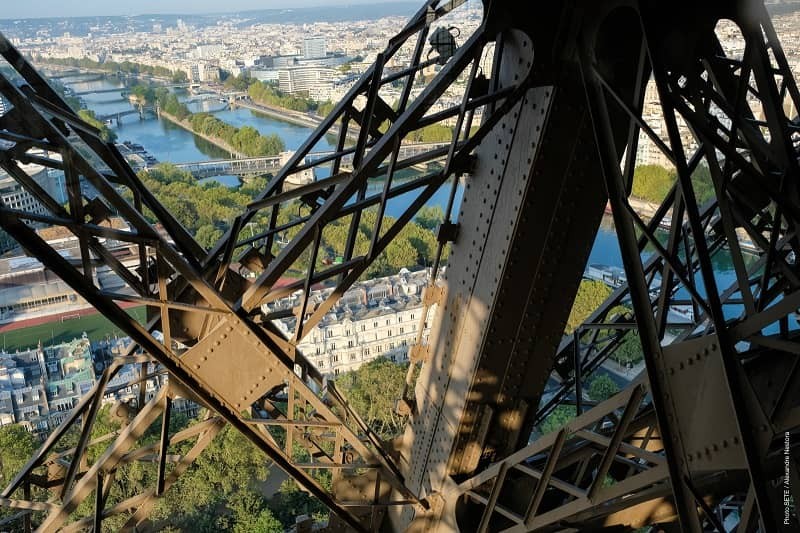The Eiffel Tower, an iconic symbol of Paris and France, stands tall as a testament to engineering ingenuity. Beyond its stunning architecture and historical significance, many are curious about its physical characteristics. One common question is: How Much Does The Eiffel Tower Weigh? Let’s delve into the details of this impressive structure and uncover the answer.
Eiffel Tower’s Composition: More Than Just Iron
The Eiffel Tower, built between 1887 and 1889 by Gustave Eiffel’s company, is primarily constructed of puddle iron, not steel. This particular type of iron was sourced from the Pompey forges in Eastern France. Eiffel’s company also built the metal framework for the Statue of Liberty.
The iron plates and beams were pre-assembled with rivets in Eiffel’s factories near Paris before being transported to the construction site. This prefab system significantly sped up the building process, allowing the Eiffel Tower to be completed in just over two years. The puddle iron was chosen for its strength and durability.
The Weight Breakdown: Iron, Paint, and All
So, how much does this iron giant actually weigh? The Eiffel Tower’s total weight is approximately 10,100 tons. A significant portion of this weight comes from the metal framework itself, which accounts for around 7,300 tons.
Interestingly, the paint that protects the iron structure from corrosion contributes a comparatively small amount to the overall weight, at about 60 tons. This paint requires regular reapplications, about every seven years, as recommended by Gustave Eiffel himself. The puddle iron went through a refining process which eliminated the excess carbon when the ore was melted. Following this process, you obtain almost pure iron, which was, according to Gustave Eiffel at that time, the best and most robust of materials.
Why the Eiffel Tower Was Built: A Showcase of Innovation
The Eiffel Tower was conceived as the centerpiece of the Paris World’s Fair in 1889. This World’s Fair showcased the advancements in iron and steel construction that defined the era. Initially called the “300-meter Tower,” it was later named after its creator, Gustave Eiffel.
The tower’s rapid construction and innovative design made it an instant sensation, attracting over two million visitors in its first year. This established the Eiffel Tower as a global icon and a symbol of French industrial prowess. Controversy over the Tower raged in the art world before and during its construction, but thanks to the audacity of its architecture and design, visitors and Parisians immediately fell under its charm.
From World’s Tallest to Enduring Symbol
Upon its completion, the Eiffel Tower became the tallest structure in the world, reaching a height of 1,000 feet. It held this title for 40 years until the completion of the Empire State Building in New York City in 1931.
Today, the Eiffel Tower remains one of the most visited monuments in the world, attracting nearly 7 million visitors annually. Its enduring appeal lies not only in its height and design but also in its representation of Paris and France. The Tower can be seen from many and various points around Paris and its suburbs. It is photographed, drawn, filmed, and replicated in all kinds of circumstances. It is the monument photographed by all visitors to Paris. It naturally slipped into the role of symbolizing France in the collective imagination, in movies and graphic arts but also in literature and poetry.
The Eiffel Tower’s Shape: Form Follows Function
The Eiffel Tower’s distinctive A-shape wasn’t merely an aesthetic choice. It was dictated by the engineering requirements of constructing such a tall structure. The tower’s design was based on calculations by two engineers working for Gustave Eiffel, who envisioned a 300-meter tower for the 1889 World’s Fair.
The four legs, composed of robust beams connected by open-web joists, were designed to provide stability and support for the massive structure. The curves and shapes of the tower are reminiscent of the large viaducts built by Eiffel around the same time, reflecting his expertise in large-scale metallic structures.
A Symbol of Paris and France
The Eiffel Tower’s weight is just one aspect of its fascinating story. From its innovative construction to its enduring symbolism, the Eiffel Tower represents French ingenuity and artistic vision. For 130 years, the Eiffel Tower has been a powerful and distinctive symbol of the city of Paris, and by extension, of France. The TDF installations and emitters at its summit broadcast all the digital terrestrial television and radio channels to the 12 million inhabitants of île de France.
Its lights have also become a means of expression for the city of Paris and all of France, often turned off at night to honor the victims of dramatic events around the world.
So, the next time you marvel at the Eiffel Tower, remember that its impressive stature is supported by approximately 10,100 tons of iron and countless stories woven into its very structure.
